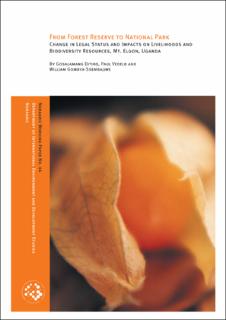| dc.contributor.author | Ditiro, Gosalamang | |
| dc.contributor.author | Vedeld, Paul | |
| dc.contributor.author | Gombya-Ssembajjwe, William | |
| dc.coverage.spatial | Uganda | en_US |
| dc.date.accessioned | 2020-09-30T12:33:08Z | |
| dc.date.available | 2020-09-30T12:33:08Z | |
| dc.date.issued | 2008-06 | |
| dc.identifier.issn | 0809-4934 | |
| dc.identifier.uri | https://hdl.handle.net/11250/2680556 | |
| dc.description.abstract | Mount Elgon forest was gazetted under the Forest Department from 1938. The status was changed to a National Park in 1993. Its management was transferred to the wildlife authorities. We assess impacts of the change in legal status on people's livelihood by means of a modified household economic model. Key informant interviews and household surveys were used for data collection.
The legal status change led to a redistribution of rights of access and control over natural resources. The change had negative effects on local people's livelihood. 72% of the households used to collect various resources from the forest reserve, while only 30% collect similar resources from the park. 14% of the households used to generate cash incomes from the forest reserve compared to only 2% reporting to generate cash incomes from the national park.
When collaborative management agreements were established after the change in legal status we found a substantial difference in resource access. We found that 40% of the households in Mutushet village with an agreement, access forest products compared to 13% in Kortek who only illegally access forest products. The collaborative agreements have thus reduced the adverse livelihood effects of the legal status change.
Even if the biodiversity conditions are reported to improve after the transition, significant decreases are still observed in stem tree counts per hectare, indicating that tree-harvesting activities continue in two studied forest patches even after the transition to a National Park.
A revised model for collaborative management is recommended where more resources crucial to people's livelihoods are included in resource use agreements. One should also facilitate increased cooperation between the Uganda Wildlife Authority and the National Forest Authority in the management of forest resources from the park and in outreach activities with local people. | en_US |
| dc.language.iso | eng | en_US |
| dc.publisher | Norwegian University of Life Sciences, Ås | en_US |
| dc.relation.ispartofseries | Noragric Working Papers;44 | |
| dc.title | From Forest Reserve to National Park: Change in Legal Status and impacts on Livelihoods and Biodiversity Resources, Mt. Elgon, Uganda | en_US |
| dc.type | Working paper | en_US |
| dc.subject.nsi | VDP::Agriculture and fishery disciplines: 900::Agriculture disciplines: 910::Management of natural resources: 914 | en_US |
| dc.subject.nsi | VDP::Social science: 200::Law: 340::Environmental law: 347 | en_US |
| dc.source.pagenumber | 48 | en_US |
